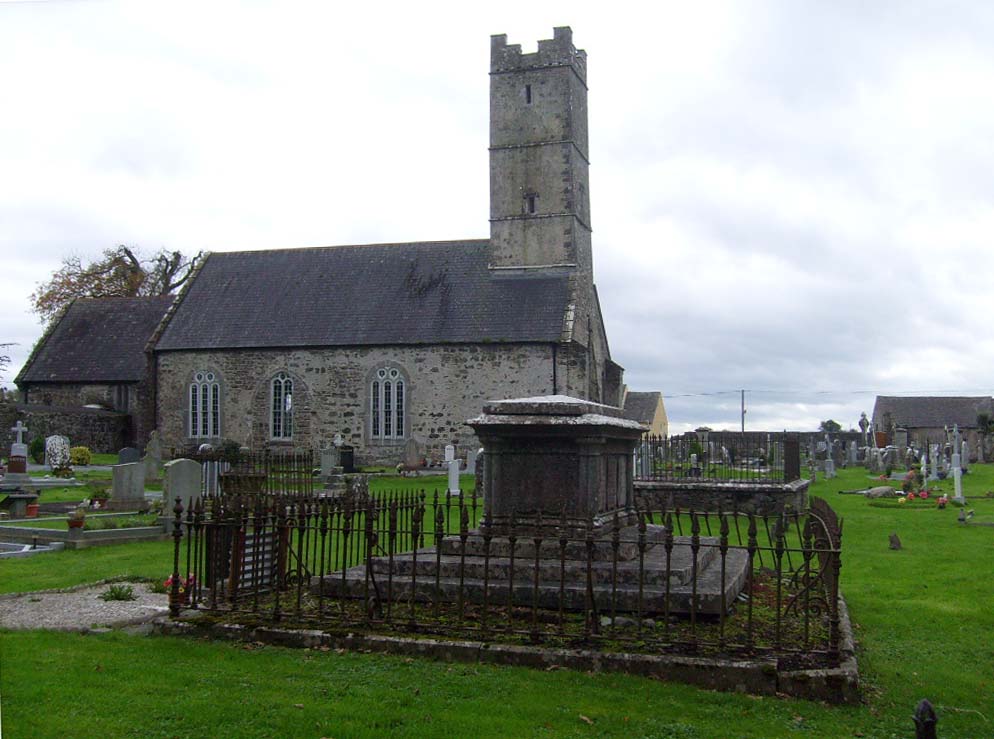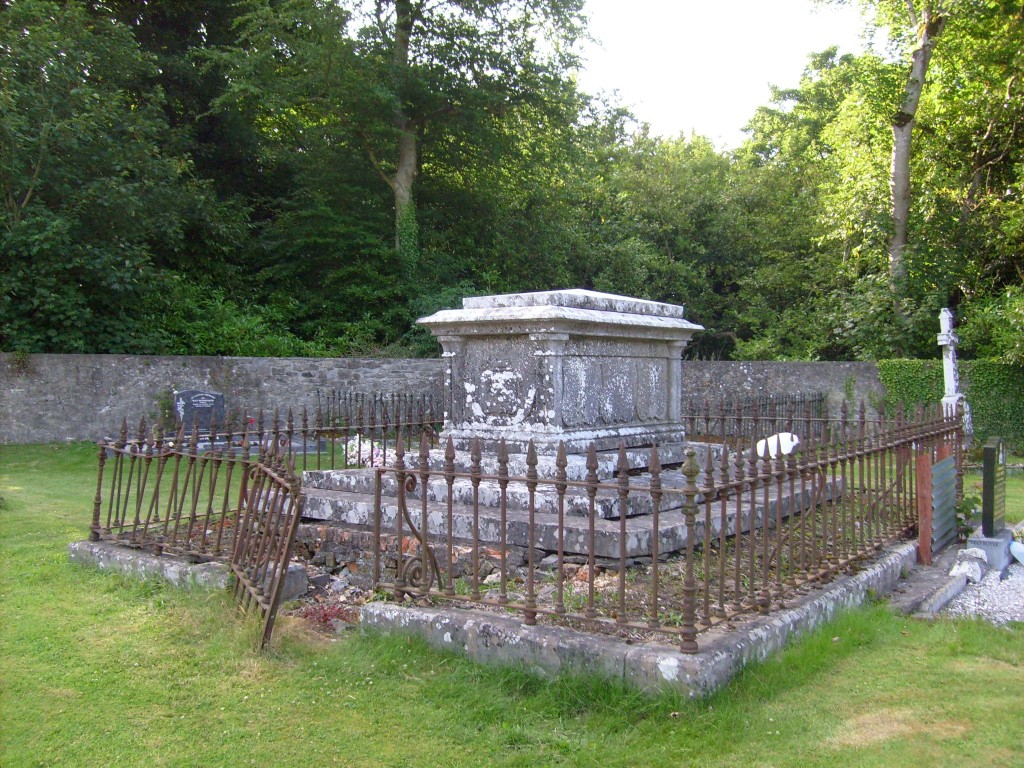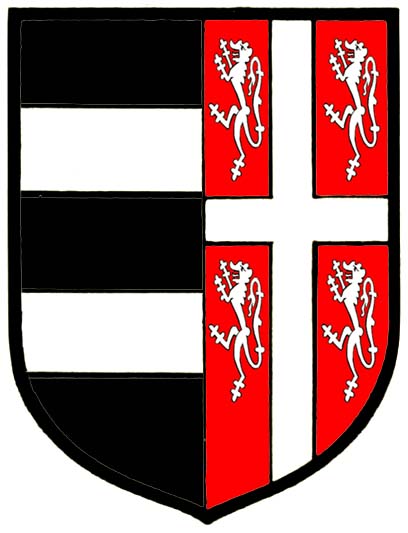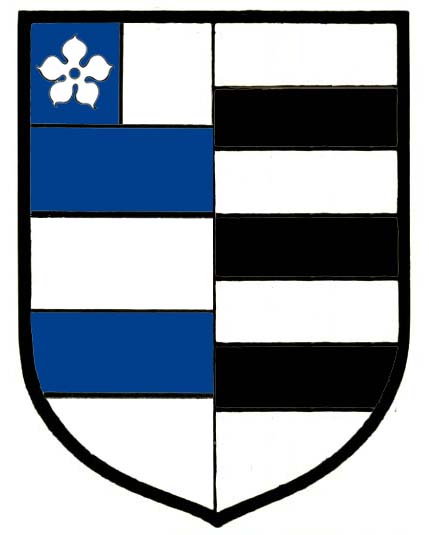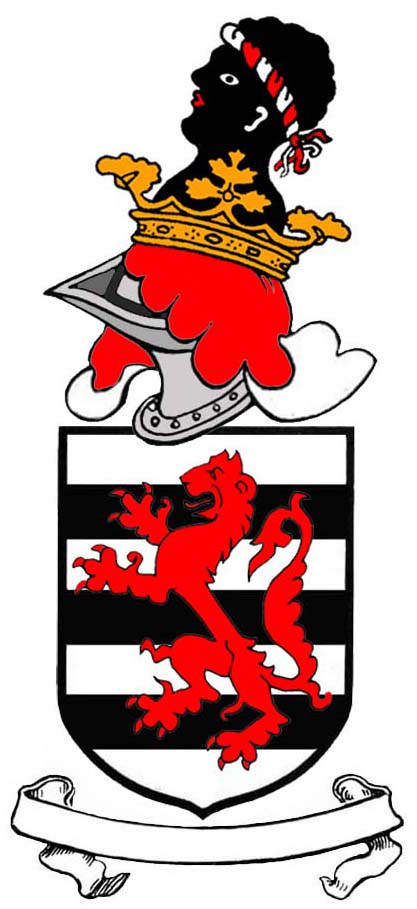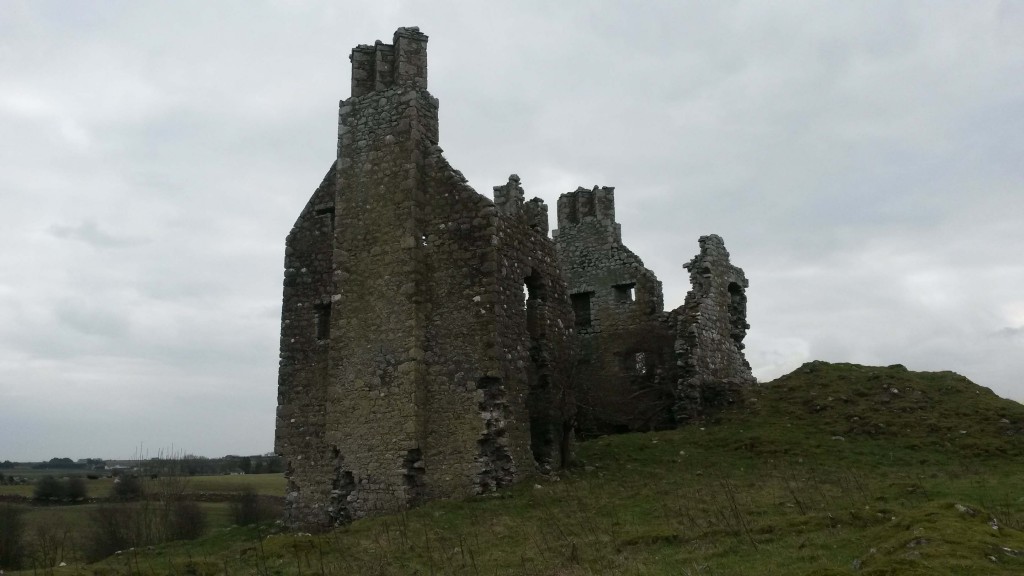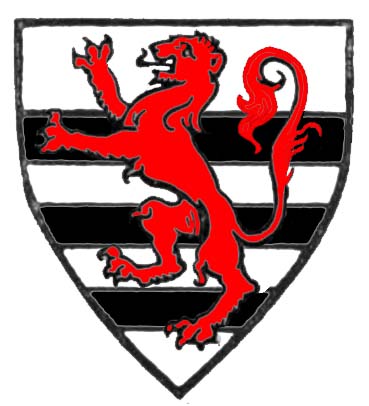© Donal G. Burke 2014
On the south face of a tomb in the graveyard of Clonfert Cathedral, the arms of the Moore family of Shannongrove in the parish of Clonfert, a junior branch of the more senior Cloghan castle and Cloonbigny lines, is given in stone as a lion rampant, in chief three mullets of six points, with, above a wreath, a crest of a cubit arm in armour fesswise holding a sword on which are mounted three moors heads. A scroll below the shield bears the motto ‘semper constans et fidelis.’ By the early twenty-first century the crest had lost the heads and the greater part of the sword, the heads reputedly struck off with a spade or similar implement by a local man in the mistaken belief that the severed and impaled heads were those of three priests.[i] The arms displayed on this tomb are the arms of a senior line of the O Moores, a Gaelic family of the midlands region and erroneously held by some of the later family of Cloghan Castle to be theirs by descent from this Gaelic family.[ii] By the late eighteenth century certain of the Moore family began to use the surname O Moore in the mistaken belief that this was a more correct version of the family surname.[iii]
The Moore family tomb in the graveyard at Clonfert Cathedral, its railings damaged by a fallen tree in the early twenty-first century.
The family of More or Moore of Cloghan Castle in the King’s County, Balla and Brieze in County Mayo, Cloonbigny in County Roscommon, and a junior line of which was later of Shannongrove in County Galway, derive their descent, through John Moore of Cloghan Castle, from the Anglo-Norman family of More of Barmeath, near Drogheda in County Louth.[iv] This John Moore of Cloghan Castle, who died in 1631, was married to Lady Mary Burke, daughter of Richard 2nd Earl of Clanricarde, and was second son of Bartholomew Moore, who lived at Athcarne about 1550, the second son of Richard More of Barmeath.[v]
The arms of Patrick Moore of Carblagh, County Meath, Clerk of the Crown for Counties Cavan and Down from 1583 to 1587 and who died on 29th April 1614, son of Bartholomew Moore of Athcarne and elder brother of John Moore of Cloghan Castle were recorded among the funeral entries in the office of the Ulster King of Arms as ‘Sable, two bars Argent.’[vi] Buried at Duleek, his funeral entry gave his wife as Elizabeth, daughter of John Bath, by whom he had issue and displayed his arms as impaled with that of Bath, the Moore arms displayed on the dexter side.[vii]
The arms of Moore. given as borne by Patrick of Carblagh, elder brother of John Moore of Cloghan Castle, on the dexter side of his impaled arms.
The impaled arms of Patrick Moore of Carblagh, who died in April 1614, elder brother of John Moore of Cloghan Castle, from the former’s Funeral Entry in the records of the Ulster King of Arms, giving the arms of his wife’s family, Bath of Athcarne, on the sinister side of the shield. N.L.I. Dublin, G.O. Ms. 66 Funeral Entries and Ms. 274 Betham Sketch Pedigrees.
While the 1614 Funeral Entry of Patrick of Carblagh was exemplified as Sable two bars Argent, the shield was marked in a manner that may suggest that it was simultaneously tricked as Argent two bars Sable but the tinctures possibly applied by the artist in reverse order. The letter ‘s’ would appear to have been written across both bars Argent and may have been intended to indicate two bars Sable. While this would be more in keeping with later variations of this family’s arms, Sir John Bernard Burke, Ulster King of Arms, in his ‘General Armory of England, Scotland, Ireland and Wales’ of 1884 gives the arms of Patrick of Carblagh from his Funeral Entry as Sable two bars Argent.
Patrick Moore and his wife Elizabeth Bath had at least six chidren; Bartholomew, William, Robert, Margaret, Rose and Jane. Bartholomew, his eldest son, described as ‘of Carblagh and Dowanstown, County Meath’, was living in 1633 and his son and heir Patrick was admitted to Gray’s Inn on 1st November 1635.
That variations of Sable two bars Argent were also attributed to members of this immediate family is evidenced by the arms of Christian, daughter of Bartholomew Moore of Dowingston (ie. Dowanstown), County Meath, who married Alderman George Peppard of Drogheda and who died in February of 1678. A widow, her arms were given in her funeral entry on the sinister side of an impaled lozenge as Argent three bars Sable, her husband’s arms on the dexter side.[viii] The arms of her husband, who died in 1676, ‘Argent two bars Azure on a canton of the second a cinquefoil pierced of the field’ were likewise impaled with his wife’s family on the sinister side, again as Argent three bars Sable but on a shield rather than a lozenge.[ix]
The impaled arms of Alderman George Peppard of Drogheda, who died in 1676 showing the arms of his wife’s father, Bartholomew Moore of Dowingston, County Meath. Peppard’s wife Christian, who died two years later, was buried alongside her husband in St. Peter’s Church, Drogheda. N.L.I. Dublin, G.O. Ms. 67, pp. 228, 250.
A compilation of tricks of arms, believed to date from between 1706 and about 1730, that once formed part of the records of the Ulster King of Arms and was later known as Genealogical Office Manuscript number 82, contained the tricked arms of the Moores of Barmeath, County Louth and of ‘Dulick’ (ie. Duleek). Both were shown tricked as Argent three bars Sable, with that of ‘Dulick’ differentiated by the inclusion of a crescent denoting descent from a second son. An accompanying contemporary note stated that ‘Moore of Connaght’ was a branch of the family of ‘Dulick’ and gave Moore of Connaght as represented by Colonel Moore, who died on 14th January 1705/6 in the 105th year of his age. (Betham’s Sketch Pedigrees, which, like G.O. Ms. 82, once formed part of the records of the Ulster King of Arms, gave Colonel Moore as born circa 1620 and so about eighty-five years at his death.) The family of Connacht to which reference was made in G.O. Ms. 82 was that of Cloghan Castle in Lusmagh and Balla and Brieze in County Mayo, whose senior-most member at the beginning of the eighteenth century was the same Colonel Garrett Moore, grandson of John More and Lady Mary Burke. The fading of ink over succeeding centuries rendered the blazon of the arms of Colonel Moore in the same manuscript indistinct and barely legible. While the shield was described as the same as that of Duleek; Argent three bars Sable, it included ‘over all, a lion rampant Gules.’[x] The blazon of the crest, however, was less legible and appears to have been a moor’s head couped wreathed but with the tinctures illegible, possibly Argent and Gules. The moor’s head was described as issuing out of a ducal coronet, but again the tincture of the coronet was rendered illegible by fading ink but may have been intended as Or. The same tricked arms for Barmeath and Duleek appear in an earlier Genealogical Office manuscript, number 60, believed to be a compilation of arms made by William Carney, Ulster King of Arms, sometime between 1650 and 1692. A similar note was appended beside the arms of Duleek, asserting that Moore of Connaght was ‘a second brother of Dulike’ and bore over all a lion rampant Gules. The crest, however, although again barely legible, appears to be that of a moor’s head couped with a wreath possibly Argent and Gules. No mention appears to be made in this case to the coronet in the crest of Colonel Moore.
The tricked arms of Moore of Barmeath and of ‘Dulick,’ from G.O. Ms. 82, with accompanying note describing the blazon of the arms of ‘Moore of Connaght,’ represented by Colonel Moore who died in January 1705/6. © National Library of Ireland.
The arms of Colonel Garrett Moore of Cloghan Castle, Ball and Brieze after those blazoned in G.O. Ms. 82.
The arms of the head of a junior branch of the Cloghan Castle family, seated at Cloonbigny, County Roscommon, were given in the eighteenth century as identical to those attributed to Colonel Garrett Moore of Cloghan Castle. The arms of Major Edmund Moore of Cloonbigny, Co. Roscommon, who flourished about the mid seventeenth century, father of Garrett Moore of Annaghbeg, Co. Galway and grandfather of John Moore of Annaghbeg, were described as ‘Argent, three bars Sable, over all a lion rampant Gules’ in an account of the descent of Lady Maria O Kelly, ‘Countess of the Roman Empire.’[xi] This Edmund of Cloonbigny, who was married to Alice Talbot, was son of William Moore of Clooncoran and Cloonbigny, third son of John Moore of Cloghan Castle by his wife Lady Mary Burke.[xii] While the Cloonbigny branch shared a common descent with the earliest senior line of Cloghan castle, from John Moore of Cloghan Castle and Lady Mary Burke, and their arms were described as the same as those of Colonel Moore of the more senior line, some differentiating mark or mark of cadency may initially have been required to indicate the Cloonbigny line as a junior line to that of Colonel Moore. Through the marriage of a Moore co-heiress to a member of the Cloonbigney branch, descendants of the Cloonbigny branch would come into possession of the Cloghan Castle estate of the more senior line in the eighteenth century.
The ruins of the seventeenth century Moore residence known as Cloonbigny Castle in the County Roscommon parish of Taughmacconnell, viewed from the north.
The arms attributed to Major Edmund Moore of Cloonbigny by the Ulster King of Arms as described in N.L.I. Dublin, Genealogical Office Ms. 164.
John Hubert Moore of Shannongrove, parish of Clonfert, Co. Galway, born in 1765, third son of John Moore of Annaghbeg, was father of Hubert Moore of Shannongrove and Annaghbeg and grandfather of Captain Butler Dunboyne Moore who was buried at the family sepulchre in Clonfert.[xiii] He was also the younger brother of Colonel Garrett O Moore of the Clanricarde Chasseurs, who appears to have been the first to adopt the ‘O’ prefix and who came into possession of Cloghan Castle. The arms, therefore, of the family of Shannongrove are correctly those of the Cloghan Castle and Clonbigney family and not that of the Gaelic O Moores given on their tomb.
It is possible that the earliest surviving example of the Moore family arms in the east of County Galway occurs on an armorial stone at Kilconnell Abbey. The crudely carved stone commemorates an armiger of the Kelly family and stands against the southern wall in the grounds of the chancel of the abbey. The elements of the composition stand in high relief from the stone itself with no clear outline of a shield other than that suggested by a scroll-like decorative element extending down from the crest to the base of what is intended as the shield. The arms given here are impaled arms, with a clear strong vertical line in relief dividing the dexter and sinister sides, the Kelly arms given on the dexter side. The arms of the armiger’s wife’s family is depicted on the sinister side, dominated by a lion rampant over what are a pair of barely-discernible incised horizontal lines in chief behind.
No inscription was provided on this stone but Rev. R.S. Maffett visited the abbey at Kilconnell in the late nineteenth century and noted in 1892 an inscription on a flat stone at the foot of the armorial stone; ‘IHS, Pray for ye Soul of Bryan Kelly of Grigan who died ye 17 of 8 Anno Domini 1751. This stone was erected by his wife Susanna Kelly alias Moore.’ It would appear likely that the armorial stone may be that of this Bryan Kelly with the arms on the sinister side a primitive representation of the Moore arms, the incised twin horizontal lines behind the lion’s head intended to represent the bars Sable of the Moores. The presence of the lion would suggest that this branch of the Moores, likely to descend from that of John Moore of Cloghan Castle, Balla and Brize, bore the lion rampant Gules charge.
The stone commemorating Bryan Kelly and his wife may have been difficult to decipher accurately on the occasion of Rev. Maffett’s visit and reads more correctly ‘Bryan Kelly of Cregan’. The Kelly armiger in this case would appear to have been a representative of the Kelly family of Creggaun House in the parish of Ahascragh, whose lands lay in the barony of Clonmacnowen, north of the town of Ballinasloe and within a short distance across the River Suck of the property of the Moores at Cloonbigny and Clooncoran. The property of this Kelly family, containing a house and demesne of over three hundred acres was advertised for letting in March of 1826, following the death of Hugh Kelly, Esq., who left no family.[xiv]
The impaled arms of a Kelly armiger at Kilconnell friary, which appears to relate to one Bryan Kelly of Cregan and his wife Susanna Kelly alias Moore. (Vigors, Col. P.D., French, Rev. J.F.M. (eds.), Journal of the Association for the Preservation of the Memorials of the Dead, Ireland, 1892, Vol. II, No. I, pp. 120-121.) Although crudely carved, the treatment of the lions rampant is similar to that employed in a number of other carved armorial stones of east Galway dating from the eighteenth century, such as that of a Lorcan armiger at Meelick and that of an Eyre at Cloonkea in the parish of Clonfert.
The lion rampant Gules charge would not appear to have been solely an heraldic innovation applied to the Cloghan Castle and Cloonbigny branches but derived from a Drogheda connection. Drawing from the registers of the office of the Ulster King of Arms, Sir Bernard Burke in his ‘General Armory of England, Scotland, Ireland and Wales’ gave for the arms of Moore of Drogheda, ‘Barry of six Argent and Sable, a lion rampant Gules’.[xv] This Drogheda family would appear to be connected to that of Barmeath as opposed to the Moore family from whom derived the Viscount Moore of Drogheda and Baron of Mellifont, who bore different arms.[xvi]
While individuals of various families of the name More or de la More bore arms in the medieval period, none are recorded as having borne arms as were later borne by those of Carblagh or Cloonbigny. Those most similar, but nonetheless significantly different, were borne by one Bartholomew de la More in the Arden and St. George Rolls of Arms from about the late thirteenth century as ‘Argent, seven barrulets Azure, a chevron Gules.[xvii]
For further details, refer to ‘families.’
[i] Information on the spoilation of the crest given by C. Cunniffe, Clonfert, Co. Galway.
[ii] N.L.I., Dublin, G.O., Ms. 165 Registered Pedigrees, p. 63.
[iii] N.L.I., Ms. 274 Betham Sketch pedigrees, pp. 133-135. From a pedigree of this family, it would appear that the first to use the name ‘O Moore’ was Garrett O Moore of Cloghan, born in 1741 and who died in 1824, the son of John Moore of Annaghbeg and Mary Hearne. This form of the name appears to have been passed down only in the line of the descendants of this Garrett O Moore.
[iv] In a deed of 1611, William Moore of Barnemeith in County Louth was given as a relative of John More of Cloghan (Cal. Patent Rolls James I, LXXIX) John More was given variously as ‘of Cloghan’ or ‘of Bryes’ in various records.
[v] N.L.I., Dublin, G.O., Ms. 274, Betham Sketch Pedigrees, Series I, pp. 133-135.
[vi] N.L.I., Dublin, G.O., Ms. 66 Funeral Entries, p. 43 and Sir B. Burke, The General Armoury of England, Scotland, Ireland and Wales, Harrison, London, 1884, p. 702. His funeral entry also describes him as ‘son of Bartholomew, second son of Moore of Barmeath.’
[vii] N.L.I., Dublin, G.O., Ms. 66 Funeral Entries, p. 43.
[viii] N.L.I., Dublin, G.O., Ms. 67 Funeral Entries, p. 250.
[ix] N.L.I., Dublin, G.O., Ms. 67 Funeral Entries, p. 228.
[x] N.L.I., Dublin, G.O., Ms. 82, p. 121.
[xi] Pedigree of O Moore of Clonbigney, Co. Roscommon and Annaghbeg, Co. Galway c. 1650-1750, NLI, G.O., Ms. 164, p.67. This Lady Maria O Kelly was daughter of Count Connor O Kelly of Tycooly by O Kelly’s wife Margaret, daughter of the same John Moore Esq. of Annaghbeg. The place of residence of this John Moore son of Garrett Moore of Annaghbeg is not given in G.O. Ms. 164 but is given as Anaghbeg in G.O. Ms. 274.
[xii] N.L.I., Dublin, G.O., Ms. 274, Betham Sketch Pedigrees, Series I, pp. 133-135. In the pedigree of Lady Maria O Kelly, certified in 1782, all members of the Moores are described as O Moore but N.L.I., Dublin Ms. 274 indicates that the O Moore form of the name descended only in the line of Garrett O Moore of Cloghan Castle who died in 1824.
[xiii] Kings Inns Admission Papers. John Hubert Moore was son of John Moore of Annaghbeg by his wife Mary Herne, son of Garrett Moore of Annaghbeg, second son of Edmund Moore of Clonbigney by his wife Alice Talbot. (N.L.I., Dublin, G.O., Ms. 274, Betham Sketch Pedigrees, Series I, pp. 133-135.)
[xiv] Dublin Evening Post, 23 March 1826. Creggaun, given as ‘Cregane’ was described as situated one mile from Ballinasloe by a foot-way and three miles by the high-road; within three miles of Ahascragh and ten of Athlone. The house was described in March 1826 as ‘a commodious dwelling house, the greater part of which is new and slated.’
[xv] Burke, B., The General Armory of England, Scotland, Ireland and Wales, Vol. I, Harrison and sons, London, 1884, p. 702.
[xvi] N.L.I., Dublin, G.O., Ms. 71 Funeral Entries, p. 331 and N.L.I., Dublin, G.O., Ms. 183 Lords’ Entries, p. 41.
[xvii] Foster, J., Feudal Coats of Arms, James Parker & Company, London, 1902, p. 77.


